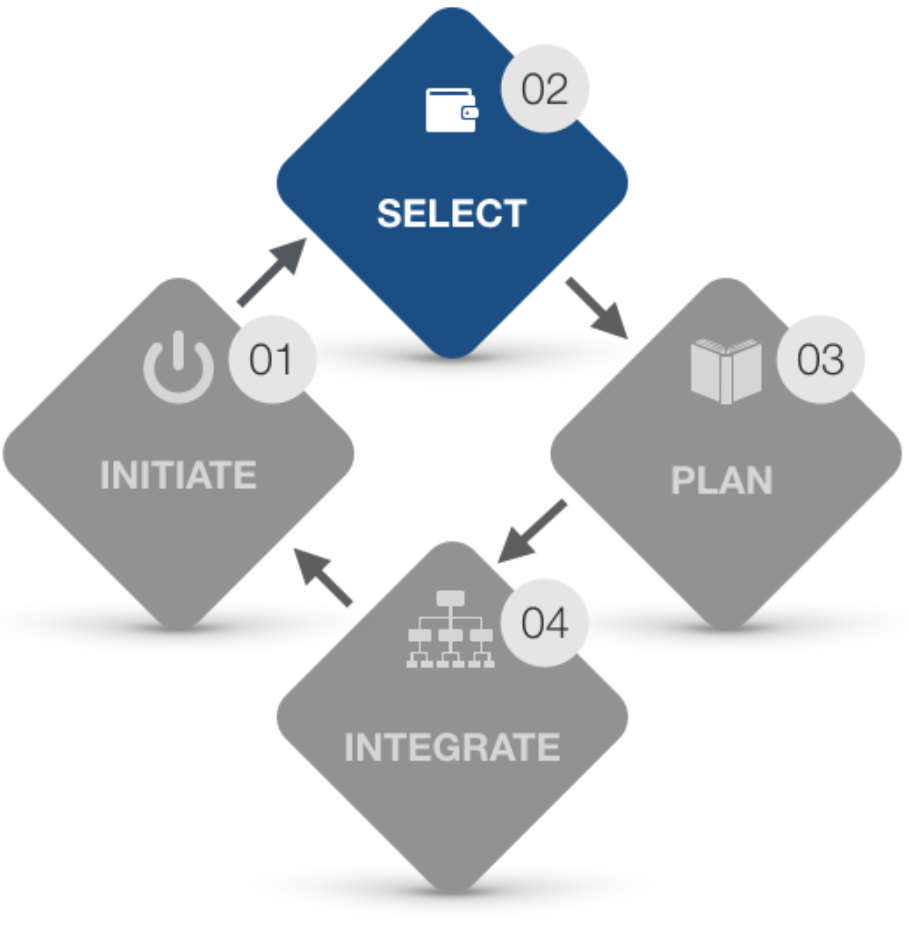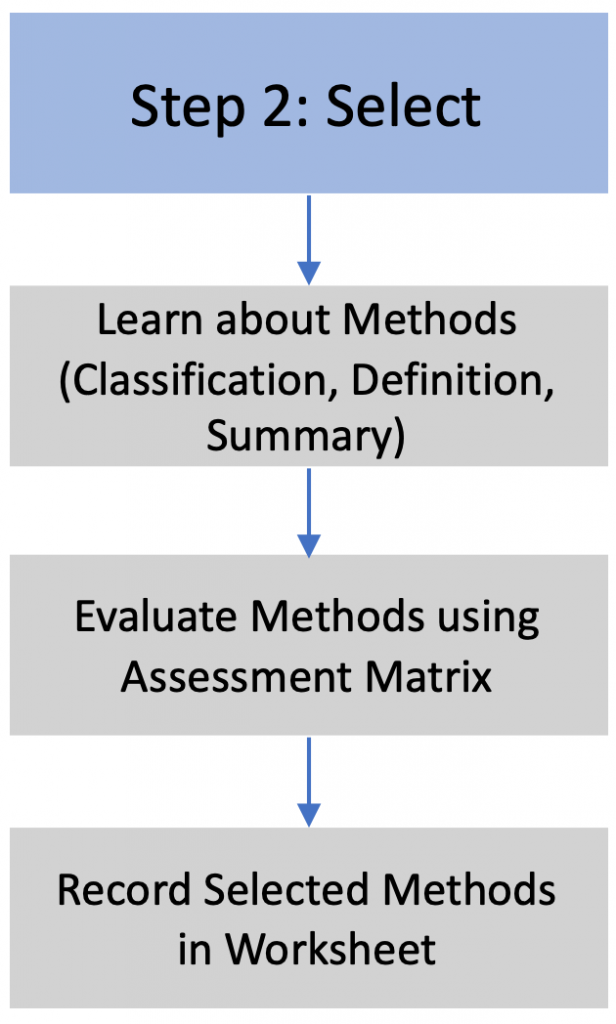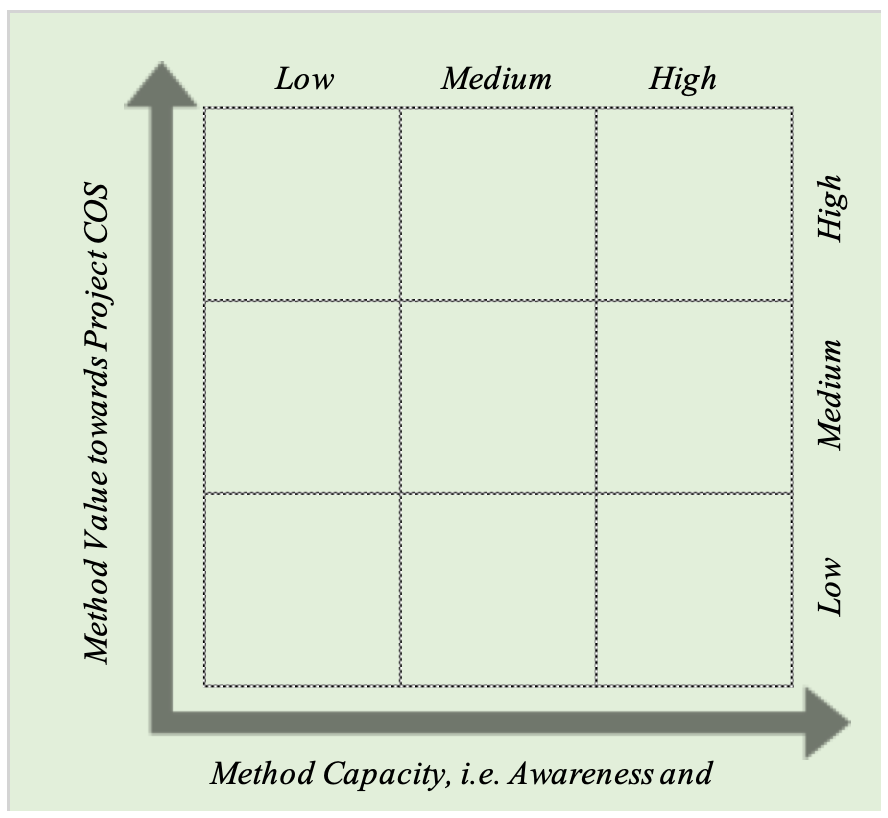4 Step 2: Select
Review and Select the Project Lean Methods
“The hardest thing to learn in life is which bridge to cross and which to burn.”
― David Russell
To deliver the value represented by the project conditions of satisfaction (P-COS), the goal of the Select step is to guide the project team through learning about methods, reviewing specific methods in terms of their value and implementation needs, and selecting methods that enable lean processes. Due to each project being unique, a different approach and set of strategies may be required to meet project specific requirements. Therefore, with every project, a different set of methods also need to be selected that are complementary to each other in delivering the critical project needs. During the lean deployment planning session(s), once the project team is onboard with the project conditions of satisfaction (P-COS), the lean coach and/or the project leader(s) should lead the project team through a collaborative method education, review, and selection process. Together all such resources are intended to help project teams brainstorm for each method in terms of their value in meeting the P-COS versus the opportunities or challenges due to the project team’s awareness and understanding of the methods; and, selecting a set of methods for lean implementation.
Evaluating Methods
Prior to selecting methods for implementation, the team needs to evaluate them in order to understand two aspects about the method. One, which methods have the potential  to really help with achieving the P-COS and two, how experienced is the project team to implement it. The method’s potential in meeting the P-COS is based on expert judgement of the lean coach and the project leadership. The project team’s comfort level in implementing a method is based on the project team’s awareness and understanding of each method. If a method helps with meeting the P-COS, and the project team also understands the foundational process supporting that method, then they will be more willing to implement that method.
to really help with achieving the P-COS and two, how experienced is the project team to implement it. The method’s potential in meeting the P-COS is based on expert judgement of the lean coach and the project leadership. The project team’s comfort level in implementing a method is based on the project team’s awareness and understanding of each method. If a method helps with meeting the P-COS, and the project team also understands the foundational process supporting that method, then they will be more willing to implement that method.
An assessment matrix (Figure 4) is recommended for use to evaluate methods prior to selection. The project team should list names of the methods in the prioritized squares. Accordingly, the priority of the methods then become evident based on its rank. Depending on the methods that rank high, the project team can further record the methods in the worksheet for future reference as well as use it during onboarding future team members.

Selecting Methods
The selection worksheet is designed to record the value of each method, the person or group responsible for implementing it, the education and/or training needs to implement it proficiently, and finally if the team is in consensus to proceed with planning for the method implementation. The team does not need to wait to make all final selections to proceed with the planning. If the team is convinced to implement specific methods, they can do so and new methods may be selected in the future depending on the value they bring to the project.

Methods Classification by Function, Process, and Phase
The methods included in this guide are organized into two functional categories to help align them with the project processes being targeted: organization and operating system. Figures 6 and 7 show frequently used methods in lean implementation classified by their function, their role in supporting various project management processes, and their timing relative to project phase, e.g. when they can be implemented. Other methods that are less common or that do not require the same level of planning by the team but still are considered in lean implementation are also included in the definitions on pages 9-10 to make project teams aware of further options. These less common methods are listed at the bottom half of the pages and are indicated using a lighter color.
Operating System Methods
Operating system methods (Figure 6) are related to the core project work and can be planned in advance for implementation when the project is about to start. For example, Target Value Design can be used to define the project targets based on customer value and then the project scope and cost can be managed to meet those targets along the project duration. This is implemented by allowing the design to be developed and the production system to be designed per the project targets offering maximum value.
Organization Methods
Organization methods (Figure 7) help align the supportive project processes that enable the project’s operating system, such as team organization, problem-solving, decision-making, etc. and help the project team set-up the groundwork before starting the project execution. For example, “Onboarding is a way for new employees to quickly acquire the necessary knowledge, skills, and behaviors to become effective organizational members.” (LCI). Thus having a pre-planned onboarding process for new project team members will increase engagement and commitment, resulting in higher performance.
Methods by Project Phase
As project teams develop, or re-visit, lean deployment at different stages of the project lifecycle, Figure 6 serves to orient project teams to the application of certain methods based upon the project development. Some methods, such as Agile planning, are quite valuable in iterative planning of design amongst inter-disciplinary project teams. Others, like Takt planning are targeted at the detailed production planning of construction tasks. Some methods can span across both design and construction, such as the Last Planner System. And a few methods, such as Choosing-by-Advantages need to be planned early, but are used on an as-needed basis, such as in critical design decision-making.
Once the classification of the methods is reviewed, specific methods can then be considered using the method evaluation matrix (Figure 4, Appendix A5 and selection worksheet (Figure 5, Appendix A6). Together, the matrix and the worksheet help the project team evaluate each method in terms of the value they bring to the customer and what is required to implement them.
Following the method selection, the team should break into working groups and develop the plans for implementing each of the identified lea methods. An A3 planning template is included to help define the key components for each method, allowing them to be customized to each project and teams’ needs.

